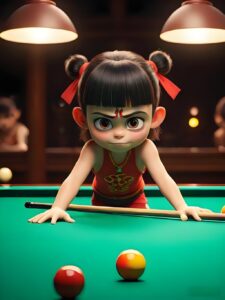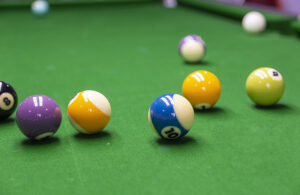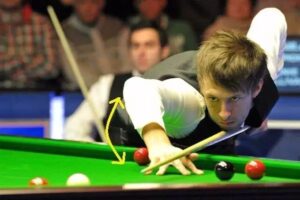When many billiards enthusiasts learn the techniques, they often fall into a misunderstanding: they think that the core of playing billiards is to “hit straight” and “hit accurately”. However, if you watch the games of professional players closely, you will find that their cues do not always point towards the pocketing point, the trajectory of their cue balls is not necessarily a straight line, and even their pursuit of accuracy is far less persistent than their obsession with controlling the cue ball.
What is the true goal of billiards?
The core goal of modern billiards is only one thing – to control the landing point of the cue ball.
The movement route of the cue ball is the true soul of this sport. How far a player can go does not depend on whether he can pocket the ball, but on whether he can precisely make the cue ball stop at the desired position.

Why is cue ball control more important than pocketing the ball? We can understand it in this way:
• Just hitting accurately without controlling the landing point of the cue ball is like playing a one-time game. You pocket one ball at a time, without continuity, and you can’t truly dominate the game.
• Controlling the landing point of the cue ball means that you are planning the next step, or even the situation several steps later, and keeping yourself in an active position all the time.
In other words, the biggest difference between professional players and amateur enthusiasts is not the pocketing rate, but the control ability of the cue ball.
How to control the route of the cue ball?
To control the movement trajectory of the cue ball, you need to train three key abilities:
1. The striking technique to restrain the route of the cue ball
Many people think that the core of playing billiards is to “make a straight shot”, but in fact, the direction of the cue does not determine the final trajectory of the cue ball. There are many factors that affect the route of the cue ball, including the hitting point, force, lateral kinetic energy, the bending of the cue, the way the tip contacts the ball, etc.
The way professional players hit the ball is to try to make the route of the cue ball stable and predictable, rather than let it change randomly. For example:
• Why do professional players like to use the “right center” shot instead of always aiming at the center point? Because this can reduce the deviation and stabilize the trajectory of the cue ball.
• Why don’t top players simply rely on hitting the bottom of the cue ball when playing a low shot? Because the bending of the cue will affect the final hitting point, which requires precise control.
If you want to improve your control ability, you need to learn the playing method that restrains the route of the cue ball, find the way of making a shot that makes the trajectory of the cue ball the most stable, instead of simply pursuing the “strongest low shot” or the “most exaggerated spin”.
2. Predicting the movement result of the cue ball
Have you ever had such an experience? When playing billiards, you clearly think that the cue ball should go in a certain direction, but it actually deviates completely? This is a manifestation of insufficient prediction ability.
The prediction ability of professional players is not innate, but trained through a large amount of observation, summary, and experimentation. For example:
• They can accurately judge the rebound angle of the cue ball after hitting the cushion, instead of relying on luck.
• They can “see” the entire movement trajectory of the cue ball before making a shot, instead of just guessing after hitting the ball.
The key to training the prediction ability lies in observation and summary. After each shot, you should pay attention to whether the actual route of the cue ball matches your preset. Where is the error? Is it a problem with the hitting point or the force? Only by constantly correcting can you make your prediction more and more accurate.
3. Repeatable and sustainable ability
Billiards is not a game decided by a single shot, but a long-term and high-intensity game. Even if you have good control techniques and prediction abilities, it is difficult to win the game if you cannot perform stably for a long time.
The advantage of professional players, in addition to their techniques, also lies in their concentration and stability. They know how to manage their energy and how to remain accurate under pressure.
If you find that you sometimes play very well, but sometimes make inexplicable mistakes, it means that your attention management is not in place. When training, you should not only practice the techniques, but also practice how to maintain a stable psychological state, so that your best state can last for a long time.

Why is “controlling the route of the cue ball” the true core of billiards?
We can compare the importance of the three abilities through a PK method:
• “Restraining the route of the cue ball” vs “Prediction ability”
The prediction ability is very important, but if the cue ball itself is out of control, no matter how accurate the prediction is, it is meaningless. Therefore, control the cue ball first, and then talk about prediction.
• “Restraining the route of the cue ball” vs “Repeatable and sustainable ability”
Maintaining the state for a long time is very important, but if the basic techniques are not up to standard, even if you are more focused, you cannot truly win the game. Therefore, the technique is the prerequisite, and concentration is the icing on the cake.
There is no doubt that the striking technique to restrain the route of the cue ball is the ultimate winner. If you can stably control the movement trajectory of the cue ball, then your prediction will become more accurate, and your attention can be more efficiently invested in the game.
Conclusion: How to train?
1. Practice the trajectory of the cue ball with a fixed hitting point
Select a certain force and a hitting point, and push the cue ball alone to observe its movement trajectory. Practice until you can stably reproduce the trajectory, and then add the training with the object ball.
2. Train in combination with the positioning target
Don’t just practice accuracy. Instead, before each shot, set the landing point target of the cue ball first, and try to make the cue ball reach there stably.
3. Record and analyze your own errors
After each training session, review the route of your cue ball, think about where there are deviations, and find ways to improve.
4. Actively observe the movement of the cue ball in the game
Don’t just stare at whether the object ball goes into the pocket, but pay special attention to the trajectory of the cue ball and think about whether it conforms to your prediction.

Billiards is not a game of pocketing the ball, but a game of control. Controlling the route of the cue ball is the only shortcut to becoming a master. https://www.tiktok.com/@spk.billiard?_t=8qRRRnXP4N8&_r=1
